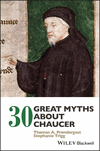THE CANTERBURY PILGRIMS FORM A “MERRY COMPANY”
Summary
The dominant image of the Canterbury pilgrimage of a merry company is closely linked to the myth of Geoffrey Chaucer's pilgrims representing a wide variety of human characters. Such celebration of difference finds many echoes in Chaucer's works such as Miller's Tale and Squire's Tale. In the decades following the composition of the Canterbury Tales, pilgrimages to local or European shrines came under increasing attack from church reformers as a frivolous, secular and inappropriately social activity. There are many other indications that the pilgrimage is not a uniformly happy occasion. The pilgrims respond to each other's stories with a mixture of emotions, from impatience, rage, envy, anger and outrage to compassion and reflective sobriety. Marion Turner challenges David Wallace's thesis about Chaucer's general “natural amiability”; for Turner, “pessimism about social possibility is everywhere apparent in Chaucer's texts".



